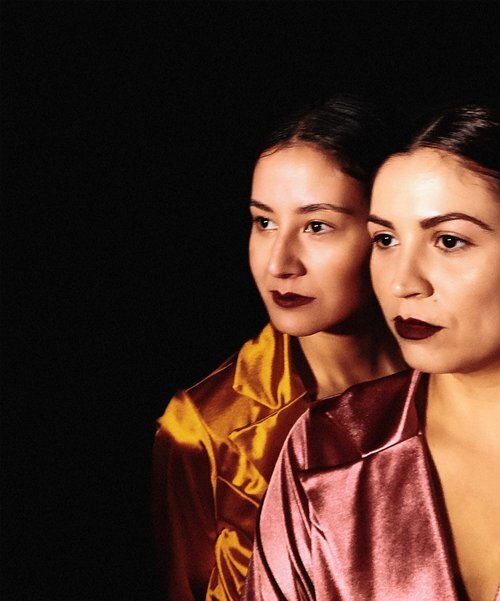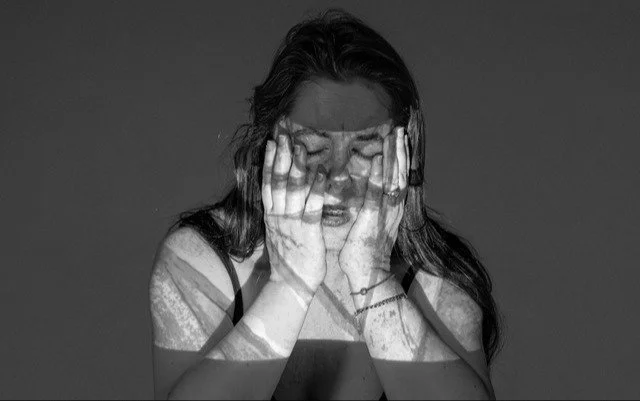MARITZA NAVARRO
Photo by Juan Toledo
Maritza Navarro is a storyteller, writer, choreographer and producer. As a first generation Mexican-American woman, her aesthetic as an artist focuses on the complex lives of minorities and how they face adversity in their diversity. Her choreography credits include ten years with the dance company LA Unbound, numerous dance festivals as well as film and choreography for live performances and musicals locally and internationally.
In this interview, she talks about her creative inspirations, her background in journalism, and her current projects with MUDA, the dance company she co-founded with Danielle Yasuda.
Interview by Uzomah Ugwu
Why did you first start dancing? How would you finish the sentence, “I am dancing today because of...?"
I started dancing thanks to the dreams of my mother, who always wanted to dance (and is a fantastic dancer), but couldn’t afford it as a child. She put me in dance at age three and is the sole reason I continued when it became my dream. I have memories of long nights driving to the nearest ballet company, an hour and a half from my small town, while I did homework in the car and she had a full time job. That was all thanks to my mother.
Now, I dance for my sanity. I am lost when I am not moving. It isn’t an option for me not to move — like breathing, it’s involuntary and physiological. Dance has become my church, my safe-haven and a place I can always come back to myself, my constant. I am dancing today because it is the most honest I can be with myself and I dance so I can share that truth.
Who are some choreographers that have directly inspired you? In what ways do you think you've taken those inspirations and used them uniquely in your own work?
Pina Bausch and her theatrics as well as the methods she used to create such honest, relatable movement inspire me constantly. I love the innovative musicality and movement technique of Merce Cunningham. Martha Graham, the mother of modern dance, and her emotional raw shapes and movement. George Balanchine for the geometry of his work — I was classically trained, so I can’t escape those first impressions of shapes on stage both in the body and in formations of people.
I feel like I take a little bit of each of these inspirations from each artist and shake it up and mix in some movement that comes from my background and culture — hips, footwork, rhythm, just feeling the music — that comes from my mother and musicality from my father. I always start there, organically with what feels right in my bones, then I layer on the theatrics, story, emotion, shapes and geometry.
You studied journalism at USC, and in a way your body is a narrator and storyteller. What aspects of your training in journalism have influenced the means by which you tell a story through dance?
I always say that despite the idea that dance and journalism seem like an odd couple — they fit hand in hand. I work in non-fiction television and film, using images and voices to tell a story — with dance I use movement, quiet moments, facial expressions, music and emotion. They have the same purpose but use a different medium.
Lately, I have blended a lot of journalism with my dance work. Using non-fiction stories woven into music and movement or using true stories as inspiration for work. I’ve used video interviews as projections behind live movement and audio interviews intercut into music for dance films. I have also researched different topics to utilize that information to inform a live performance. My work in journalism taught me to really dig into a subject and feel like I know a topic objectively, to then create a story from the information I’ve found — then I create the movement on top of that.
You co-created a dance company called MUDA with your friend Danielle Yasuda. What has the collaborative process and creative chemistry been like with her?
Danielle is an angel. I can honestly say I wouldn’t be here without her. I trace it back to a very magical night where we both had a bit too much to drink and she brazenly texted me and told me I needed to start a company and she’d join. Through a lot of workshopping, choreographing and performing over the last few years she became a partner instead of a part of my company. She is brilliant and our work is always taken to new levels because of her — both in movement and aesthetic presentation. She is my creative compass and I am so grateful for her. The way we work can’t really be described. We have created a bit of our own language with movement, so creating together is always a pleasure — and unfolds organically and oftentimes with only a few words exchanged the entire session, but always a lot of laughter and a few tears too.
Danielle Yasuda and Maritza Navarro - photo by CK Nelson
In performances, MUDA has incorporated multimedia, such as projected video interviews. How closely were you involved in the multimedia production for the performances? How do you think the mix of multimedia with live performance enhances the experience for the audience?
Because of my background in non-fiction and my love for interviewing people, I always produce, direct and edit the interviews and accompanying media for our work myself. I see it as an opportunity to exercise the two sides of my passions — so I don’t feel like I’m living two lives as an artist. I really enjoy being able to take the concept from real stories to an emotional live performance and direct each piece along the way.
With [the MUDA show] Hyper-Ventilate — I researched, partnered with ADAA for statistics, and pre-interviewed twenty-six people who live with anxiety and depression. A few months later I interviewed eleven of these humans on camera (with the help of an amazing crew), which was truly one of the most moving and incredible weekends of my life.
My day job is a story producer/editor so I took these eleven interviews and created a storyline for the show from the voices. I passed each piece to the composers — who each collaborated with me to create an original soundtrack to the voices. Then I reworked the interviews and passed it to a VFX artist and our kind DP to color the beautiful interviews and create a look that would work with the live show.
For me, multimedia is like adding a sixth sense for the audience to experience a moment. Sometimes dance and art is more abstract and can touch a wider audience because it’s left up for interpretation, but other times it can alienate an audience who might not understand the art or see themselves in it. With the work we’re creating, I really felt that allowing the audience to hear and see real voices while watching the movement gives the experience a human context that is impossible to ignore and easier to relate to. The audience is invited inside the mind a bit more and given a human soundtrack to the piece of art.
Hyper-Ventilate - photo by Gregory JM Kasunich
What made you decide to explore the topic of mental health?
Hyper-Ventilate was born out of a personal necessity to express and release my immediate experiences in life at the time. In 2014, I felt a strong need to create a show that incorporated both my passions, documentary and dance. At this point in our lives, Danielle and I had been dealing with anxiety and panic attacks for years — and had numerous conversations about it outside of dance. It felt natural that we would make our first live show about something that was on the tip of our tongues and that we felt no one had tackled in a way that both made people suffering feel seen and explained it to those who didn’t understand it. I had spent years talking about my anxiety with friends and family — and at the time the language about anxiety was developing — it still is.
How important is music selection when you have a theme? Do the lyrics of a piece go with the theme or is it more the instrumental that works best with the choreography?
Music is so important! If we’re working with a composer, I always choose a few songs that match the mood/tempo/tone of the piece and then we work from there to create something that feels right for the performance.
As far as lyrics…sometimes I choose things that have nothing to do with the work and other times, like our Dia de los Muertos performance, the lyrics directly address the topic — such as police brutality, racism and immigration. Movement-wise, I tend to choreograph to both lyrics and instrumental and rhythm or even silence — I find the oddest things to move to — and don’t use counts sometimes, but instead the inflection of a voice — as in Hyper-Ventilate when we were choreographing to some of the speaking voices.
What are some typical core procedures or preparations that need to be done to have a successful show? Does it change by the subject of the show?
We’ve only produced one show as MUDA so far. The preparation for that was a huge labor of love on all our parts and took years to complete…five in this case. But to me — a successful show relies on the hearts of all the artists involved. I was so lucky to work with people who really believed in the message and I feel it showed in the performances.
What do think of flash mobs and their effect through dance and movement? Is it a good or bad thing for statement performances such as yours and others?
I think flash mobs are like a Billboard for dance. At best they can be beautiful, touching and really brilliant pieces of public art and we all need more art! At worst, they are still a visible piece of movement that involves a community of people, brings them together and exposes a different crowd to movement. I always see any creation and movement as positive — there is no good or bad effect for my work — it really lies somewhere in between where we’re adding to the fabric of art and creativity in some way. There’s always room for more.
What's coming up for MUDA in the near future? Any particular performances or shows that you would like people to know about?
MUDA is in the process of trying to tour Hyper-Ventilate and find hosting cites and/or venues to bring the show to more audiences and raise money to do so. Our fiscal sponsor Dance Resource Center is kindly hosting our tax-deductible donations on their site – so if you believe in our process we appreciate any funding or donations we can put toward touring the show!
We are also in the middle of creating a year-long digital dance installation that consists of twelve dance films and journal entries — starting November 2019 and screening over the next year. We’re very excited to premiere this ongoing work.
Main page photo by Juan Toledo
Uzomah Ugwu is a poet, writer, and activist. Her core focus is on human rights, mental health, animal rights and the rights of LGBTQ persons. Her writing has been featured in Prelude Magazine, Tuck Magazine, Voices of Eve and Light Journal, and is forthcoming in the Angel City Review and the Scarlet Leaf Review. She is the Contributing/Poetry Editor for A Tired Heroine magazine. Her love for art comes from a passion instilled by her mother. Some of her favorite artists include Louis Bourgeois, Jarlath Daly, Gauguin, Lamidi Olonde Fakeye, and Jackson Pollack.








